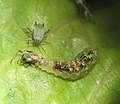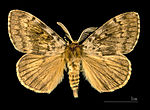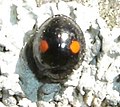Biological control or biocontrol is a method of controlling pests, whether pest animals such as insects and mites, weeds, or pathogens affecting animals...
91 KB (9,475 words) - 17:57, 22 November 2024
Pest control is the regulation or management of a species defined as a pest; such as any animal, plant or fungus that impacts adversely on human activities...
51 KB (5,687 words) - 13:56, 31 October 2024
Integrated pest management (IPM), also known as integrated pest control (IPC) that integrates both chemical and non-chemical practices for economic control of...
36 KB (4,046 words) - 01:42, 24 October 2024
integrated pest control. It means only the use of physical means to control pests. Biological pest control Kaolin spray "Mechanical pest explanation"...
2 KB (247 words) - 11:07, 6 February 2024
Persian powder (section Biological pest control)
been used for centuries for the biological pest extermination of household insects, garden pests, and agricultural pests. It may first have been exported...
3 KB (237 words) - 21:42, 18 August 2024
maintaining natural pest control is important to humanity's ability to grow crops. It can also be applied within horticulture. Biological pest control can reduce...
38 KB (3,960 words) - 02:21, 21 November 2024
would be impossible using physical control. Pest control Biological pest control Garden guns Mechanical pest control Mahr, D. L., and N. M. Ridgway."The...
7 KB (974 words) - 16:25, 19 November 2024
parasitoids and predators have been introduced as biological control agents in attempts to help control this moth. Beginning in the late 1800s, at least...
14 KB (1,290 words) - 01:48, 3 October 2024
(family Syrphidae), which are useful as biological pest control agents because they eat aphids and other pests. Seeds Gledhill, David (2008). "The Names...
5 KB (472 words) - 11:21, 25 November 2023
Inundative application (category Biological pest control)
application of a biological control or natural enemy of a pest refers to the release of overwhelming numbers of a mass-produced biological control agent in the...
1 KB (121 words) - 07:51, 4 February 2023
Acmella oleracea (section Biological pest control)
Acmella oleracea is a species of flowering herb in the family Asteraceae. Common names include toothache plant, Szechuan buttons, paracress, jambu, buzz...
11 KB (1,050 words) - 17:56, 14 September 2024
Parasitoid wasp (section Biological pest control)
naturally control agricultural pests. Some are applied commercially in biological pest control, starting in the 1920s with Encarsia formosa to control whitefly...
36 KB (3,535 words) - 23:53, 23 September 2024
Biopesticide (redirect from Biological insecticides)
A Biopesticide is a biological substance or organism that damages, kills, or repels organisms seens as pests. Biological pest management intervention...
17 KB (1,915 words) - 21:20, 4 September 2024
Chrysopidae (section Use in biological pest control)
interest in further research to improve the use of green lacewings as biological pest control. Species that have hitherto attracted wider study and are more...
16 KB (1,632 words) - 08:19, 13 October 2024
Dactylopius (section Biological control)
important because several species have been used as agents of biological pest control, and because several are known as invasive species. In general...
13 KB (1,403 words) - 14:39, 4 January 2024
considered pests, such that it can provide biological pest control in agricultural settings. It is not solely able to suppress any populations of a pest species...
26 KB (3,073 words) - 22:44, 1 October 2024
Hippodamia convergens (category Biological pest control beetles)
primary food resource. Aphids are a known pest, so the H. convergens has been used as a method to control aphids by releasing the beetles to act as a...
15 KB (1,658 words) - 18:44, 9 August 2024
shortened to resurgence in pest management contexts, can be described as a constraint of pesticide use, by which they fail to control pests such as insects and...
5 KB (583 words) - 08:42, 3 July 2024
Adalia bipunctata (category Biological pest control beetles)
states and provinces. It is commonly introduced and imported as a biological control agent. The two-spotted ladybird was one of the many species originally...
9 KB (1,061 words) - 03:20, 27 October 2023
Mite (section Biological pest control)
Fenemore PG (2016). "Chapter 7: Mites and other non-insect pests". Plant Pests and Their Control. Elsevier. p. 112. ISBN 978-1-4831-8286-5. Harrison S, Knott...
47 KB (4,996 words) - 10:24, 5 September 2024
Trichogramma (category Biological pest control wasps)
minutum has been investigated as a method of biological control of the Choristoneura fumiferana, a major pest of spruce and fir forests. Nine species of...
23 KB (2,563 words) - 21:50, 21 May 2024
Chilocorus stigma (category Biological pest control beetles)
groves. It is beneficial against non native species. An introduced Hemlock pest, the elongate hemlock scale (Fiorinia externa Ferris), which has been doing...
4 KB (425 words) - 07:30, 1 May 2024
Encarsia formosa (category Biological pest control wasps)
greenhouse whitefly, one of the first to be used commercially for biological pest control, from the 1920s. Its use fell with commercial pesticides in the...
4 KB (378 words) - 10:01, 18 November 2024
conventional one they are used to. Biological control or biocontrol is a method of controlling pests, whether pest animals such as insects and mites,...
26 KB (6,588 words) - 19:33, 7 August 2024
Sceliphron caementarium (category Biological pest control wasps)
Sceliphron caementarium, also known as the yellow-legged mud-dauber wasp, black-and-yellow mud dauber (within the US), or black-waisted mud-dauber (outside...
12 KB (1,194 words) - 08:42, 15 November 2024
Dead hedge (category Biological pest control)
can be used to create habitats for natural 'biological control agents' to provide biological pest control.[citation needed] They have roles in the tending...
4 KB (390 words) - 22:14, 7 September 2024
Aphelinus mali (category Biological pest control wasps)
pest of apple trees. It is native to the northeastern United States but has been introduced to other parts of the world as a biological pest control agent...
4 KB (441 words) - 15:17, 14 October 2023
error Control variables, variables which are kept constant during an experiment Biological pest control, a natural method of controlling pests Control network...
9 KB (989 words) - 07:50, 18 October 2024
Coleomegilla maculata (category Biological pest control beetles)
predation. Augmentative biological control recognises that lady beetles may be present but may be insufficient in numbers to control the pest species and seeks...
9 KB (1,114 words) - 21:48, 21 May 2024
Tachinidae (category Insects used as insect pest control agents)
important natural enemies of major insect pests, and some species actually are used in biological pest control; for example, some species of tachinid flies...
18 KB (1,886 words) - 00:00, 2 October 2024






















